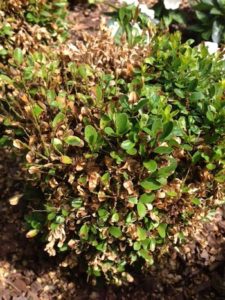Boxwood blight detection is an essential skill for homeowners and gardening beginners alike. This fungal disease, caused by the pathogen Calonectria pseudonaviculata, can wreak havoc on the classic and beloved boxwood shrubs, turning luscious greenery into a dismal brown and yellow. But fear not, with the right knowledge, you can spot the early signs of blight and take action to protect your plants.
Identifying Boxwood Blight
The first step in boxwood blight detection is knowing what to look for. The disease often starts with dark or light brown spots on the leaves, which can quickly lead to defoliation. You may also notice black streaks on the stems, which is a telltale sign of the fungus’s presence. In later stages, the leaves turn yellow, and large sections of the shrub may brown and die.
What Causes Boxwood Blight?
Blight thrives in warm, humid conditions, often spreading through water splash, infected tools, or even wind. It’s crucial to understand that once a boxwood is infected, the disease can spread rapidly to other nearby boxwoods, making it a serious threat in areas like USDA zones 6a-7a, where boxwoods are a popular choice for landscaping.
Treatment and Prevention
Once you’ve detected boxwood blight, it’s imperative to act swiftly. Begin by pruning the affected areas, ensuring to disinfect your tools afterwards to prevent further spread. Fungicides can be effective, but they must be used as a preventative measure rather than a cure. To avoid boxwood blight, it’s advisable to select resistant varieties, provide good air circulation around your plants, and practice good sanitation by cleaning up fallen leaves and debris.
Conclusion
For homeowners and gardening novices, understanding boxwood blight detection is crucial for maintaining the health and beauty of your shrubs. With vigilance and proper care, you can prevent the spread of this disease and enjoy the full splendor of your boxwood hedges. Remember, the key to combating boxwood blight lies in early detection and prompt, consistent treatment.
Follow our blog for more helpful tips!

